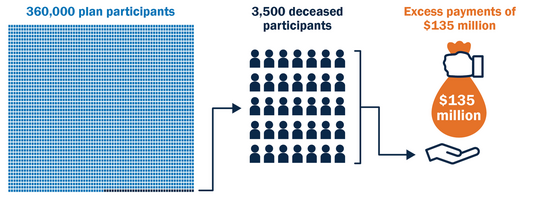|
Our job is to oversee pandemic relief funding to fight fraud, waste, and abuse in federal programs. We recently helped one of our partners recover $135 million in improper payments to deceased individuals.
How can we make sure that taxpayer money went to those eligible for help? By working together to use data analytics to assess risk, we can identify, recover, and ultimately prevent improper payments. Read on for more on how the PRAC and our partners are getting results from a collaborative, data-driven approach to oversight.

|
|
The Program:
The Special Financial Assistance (SFA) Program was established as part
of the American Rescue Plan Act (ARPA) in 2021 and is administered by the Pension Benefit Guaranty Corporation (PBGC). The SFA program aims to protect millions of workers in multiemployer pension plans (MEPs) who faced benefits cuts and, in many cases, massive benefits reductions. ARPA made up to $91 billion dollars in funding available for troubled MEPs through PBGC and the SFA program.
|
|
The Problem:
PBGC had 120 days to review applications from pension plans involving hundreds of thousands of plan participants. Prior to the PRAC's involvement, this was handled manually by a small staff. Despite PBGC's best efforts, approximately 3,500 deceased participants were included among the more than 360,000 plan participants in the accepted applications, resulting in excess payments of nearly $127 million. An additional $8 million was identified to bring the total to $135 million in improper payments.
|
|
The Partnership Solution:
The Pension Benefit Guaranty Corporation Office of Inspector General (PBGC OIG) turned to the PRAC's data analytics center to develop risk scoring models to help automate the manual process. Risk scoring models also helped PBGC OIG successfully identify and act upon potential risks.
The risk model and corresponding interactive dashboard built by PRAC data scientists supercharged the OIG’s work. According to Deputy Inspector General Brooke Holmes, these tools enabled the OIG to “at a glance, spot risky applications within the model’s nearly 1,300 multiemployer plans, each with over 10 years of entered data.” By identifying the riskiest applications, the OIG could then target its limited resources to the highest-priority issues.
"In particular, the risk model assisted us in identifying a weakness in the Special Financial Assistance (SFA) process."
-Brooke Holmes, PBGC OIG Deputy Inspector General
|
|
The Result:
This collaboration resulted in two plans returning $135 million to the Treasury Department. Additionally, millions of dollars in questioned costs for previously approved SFA payments and funds were found and put to better use for ongoing applications for SFA.
The PRAC’s data analytics support also assisted the OIG in finding a weakness in the SFA process that could be corrected to prevent further improper payments.
|
|
The Way Forward:
By using data analytics to help quickly automate a labor-intensive process and by combining years of data to build a risk model to assess applicants, the PRAC and PBGC OIG were able to achieve real results. Together, we recovered millions of dollars for the taxpayer and recommended immediate fixes to prevent erroneous payments going forward.
This successful collaboration we’ve proven with PBGC OIG and other partners in pandemic oversight can prove invaluable beyond pandemic funds to strengthen federal programs—not only during national emergencies, but all the time. As the PRAC approaches its mandated sunset in September 2025, the government risks losing this essential tool that helps protect taxpayer funds.
|
|
|
|
|